Titration Explained
Scientists often need to figure out the concentration of an acidic solution. To do so, they use a process called titration. Using this process, scientists combine the unknown solution with a basic solution to neutralize it, then measure the pH level in the neutral solution. This allows them to calculate the acidity of the original solution.
Properties of Acids
Properties of Acids
Acids are solutions that have a pH level of less than 7. This means that there are more hydrogen ions in the solution than would be found in pure water. Strong acids have more hydrogen ions than weak acids.
All acids have a sour taste. According to Canadaconnects.ca, a website providing introductory information about chemistry topics, strong acids can be dangerous as they can burn exposed skin.
Neutralizing Acids With Bases
Neutralizing Acids With Bases
Acids can be neutralized by solutions called bases; this chemical reaction is the key to titration. Bases are solutions that have a pH of greater than 7, a bitter taste and a slippery or soapy feel.
When acids are mixed with bases, the chemical reaction results in the formation of water and some type of salt. In titration, scientists attempt to cause this chemical reaction to determine the concentration of acid in an unknown solution.
Overview of Titration
Overview of Titration
Titration is the process by which scientists neutralize an acidic solution to determine its concentration. First, a specific quantity of the solution to be analyzed is poured into a flask. An indicator is also added to the flask. The indicator will change color when the solution is neutralized.
A specific quantity of a known, or standard, solution is placed in a buret. The buret is suspended over the flask; the scientist gradually releases the standard solution into the flask until the flask changes color. Once this chemical reaction has occurred, the scientist calculates the concentration of acid in the unknown solution based on the volume of standard solution needed to neutralize it.
Equipment used for titration
Equipment used for titration
The solution being analyzed is usually poured into an Erlenmeyer flask. This flask has a conical shape and contains measurement markings to make it easy to determine the volume of a solution in the flask.
The standard solution is put into a buret. A buret is a cylinder similar to a syringe, with measurement markings and a stopcock on the bottom. Burets are used to deliver precise amounts of a liquid into a solution.
The solution being analyzed is usually mixed with an indicator. An indicator is a small amount of a compound that changes the color of a solution based on the pH level in the solution.
Example of Titration
Example of Titration
Suppose a scientist wants to find out the concentration of acid in a nitric acid solution. First she would pour 25 mL of the solution into a 250 mL Erlenmeyer flask. Then she adds a 0.115 M NaOH solution–a standard solution–to her buret and suspends it over the flask. She then adds an indicator to the flask before opening the buret to slowly add the NaOH solution into the acid solution.
When titration is complete, the solution in the flask turns red. The scientist measures the volume of standard solution added to the flask.
Once the scientist has this data, she performs a series of calculations to figure out the ratio of standard solution to the nitric acid and convert it into moles. The end result of these calculations is the concentration of acid in the acidic solution.
Cite This Article
MLA
Ori, Jack. "Titration Explained" sciencing.com, https://www.sciencing.com/titration-explained-6368209/. 24 April 2017.
APA
Ori, Jack. (2017, April 24). Titration Explained. sciencing.com. Retrieved from https://www.sciencing.com/titration-explained-6368209/
Chicago
Ori, Jack. Titration Explained last modified August 30, 2022. https://www.sciencing.com/titration-explained-6368209/
